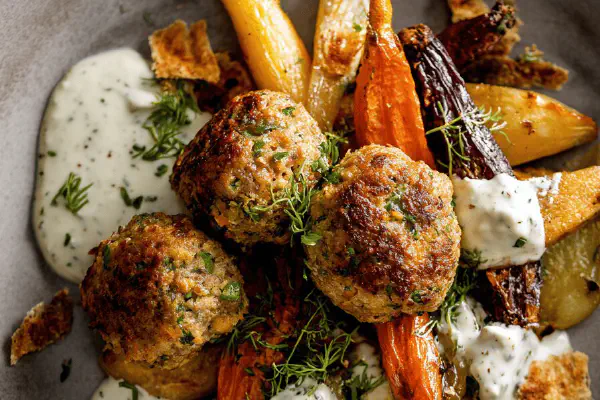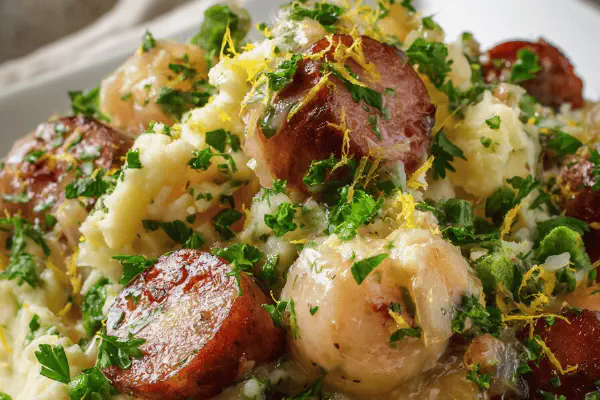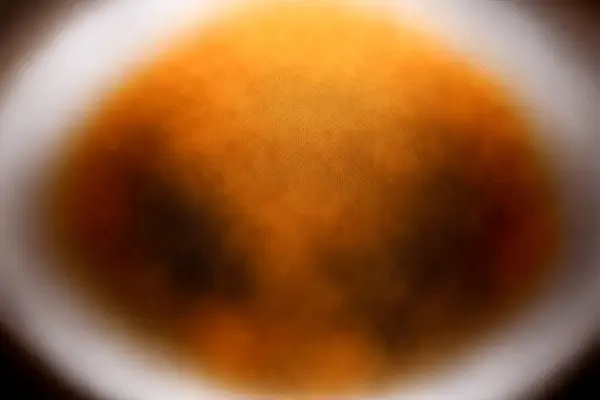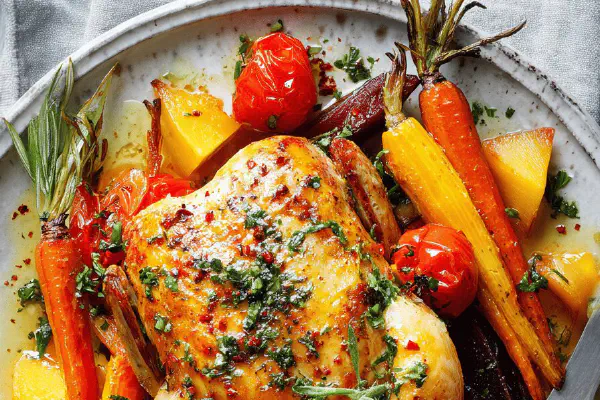Chicken Pot Pies in Ramekins

By Emma
Certified Culinary Professional
Ingredients
- 1 medium onion, finely chopped
- 1 clove garlic, minced
- 100 ml (7 tbsp) unsalted butter
- 75 ml (5 tbsp) all-purpose flour
- 500 ml (2 cups) chicken stock
- 600 ml (2 1/2 cups) cooked chicken, cut into 2 cm cubes
- 200 ml (3/4 cup) diced turnip, peeled and blanched
- 125 ml (1/2 cup) frozen corn kernels, blanched
- 5 ml (1 tsp) fresh tarragon, finely chopped (optional)
- 5 ml (1 tsp) fresh chives, chopped
- Salt and black pepper to taste
- 1/2 package (400 g) puff pastry block from store
To glaze
- 1 egg, lightly beaten
- 30 ml (2 tbsp) milk
About the ingredients
Method
Filling preparation
- Start by melting the butter in a heavy-bottomed saucepan over medium heat. You want it foaming gently but not browning. Toss in the chopped onion and garlic. Stir often; smell should shift from sharp raw to mellow sweet. After about 2 minutes, sprinkle in flour. Stir continuously, scraping the bottom to avoid lumps, cook roux for 3 minutes until it smells nutty but not burnt.
- Slowly whisk in the chicken stock, bringing mixture to a low simmer. Sauce thickens gradually; patience here ensures silky texture, not gluey. Once thickened, fold in cubed chicken plus the blanched turnips and corn. Add tarragon and chives. Season liberally with salt and freshly ground black pepper. Taste it—needs lift, balance? Adjust herbs or seasoning now before filling cools. Spoon this thick filling evenly into eight 125 ml (1/2 cup) ramekins. Set aside.
Pastry assembly and freezing
- Flour your workspace lightly. Roll out puff pastry to roughly 32 x 18 cm (13 x 7 in), thinner than original; pastry thickness impacts baking time and flakiness. Use a round cutter matching ramekin diameter to cut 8 circles. Lay each circle atop the ramekins, sealing edges by pressing gently with fingers or fork. You want snug edges but no pressing hard enough to flatten filling. At this point, wrap individually in plastic wrap and place on a tray in freezer for quick chill (1 hour minimum) or keep frozen overnight.
Baking after freezing
- When ready, preheat oven to 195°C (380°F). Whisk egg with milk for glaze. Brush the frozen pastry tops with this mixture. Pastry will be pale but glossy. Bake for approximately 38-43 minutes or until pastry puffs fully and turns golden amber. Watch edges for color change; if tips darken too fast, loosely tent with foil. The filling beneath should bubble softly at rim, signaling heat penetration. Remove and cool just enough to not scald before eating.
Notes on timing and substitutions
- Turnip comes from past experiments swapping carrots—less sweet but more earthy, keeps the bite alive. Corn replaces peas, adding crunch contrast. If frozen peas available, no harm in mixing. If butter is unsalted and stock low in salt, adjust salt carefully; always taste. For pastry, store-bought puff better than shortcrust here — gives airy lift. No freezer? Bake directly but reduce bake time by 10 minutes and watch closely for soggy base. Leftovers reheat well in oven covered loosely with foil.
Cooking tips
Chef's notes
- 💡 Butter slowly melted to foam, no browning or you get bitter undertones. Add onion and garlic—onion softens, garlic aroma changes real fast. Stir often, watch for softened smell not caramelized. Flour sprinkled in, constant stirring avoids lumps completely. Roux cook time matters: 3 minutes till nutty smell but no burn. Roux thickness sets whole sauce texture. Next, slowly add chicken stock whisked in, patience essential; breaks up lumps, prevents gluey sauce.
- 💡 Filling mix: cooked chicken last. Keeps texture, no soggy meat bits. Blanched veggies optional, but raw bites wreck mouthfeel. Turnips swap carrots here; sturdier texture, less sweet. Corn adds crunch contrast, peas okay if you're out. Herbs minimal, tarragon optional—too much kills subtle chicken flavor. Season well at end; salt stock low, so taste carefully. Spoon hot filling but not boiling into ramekins; too hot softens pastry later, too cold risks clumping.
- 💡 Pastry rolled thinner than usual—about 32 x 18 cm here, thinner means faster bake, less dough bulk. Use cutter same size as ramekin rim; seals better, edges snug but don’t press down hard or filling leaks. Freezing assembled pies firm up pastry; easier handling, no shrinkage in oven, keeps shape. Wrap individually to avoid freezer burn. Freeze minimum an hour or overnight, no skipping. Frozen pies always bake at 195°C for crispy tops and set filling.
- 💡 Egg wash crucial: beat egg and mix with milk thoroughly. Milk dilutes yolk, lighter tone on pastry. Brush frozen tops only once; uneven glaze bakes patchy spots. Bake time 38-43 minutes, watch color turn golden amber slowly. If edges darken fast, tent with foil loosely to prevent burnt tips. Bubble beneath crust shows filling is hot and set; if no bubbles after 40 mins, oven temp might be low or filling too cold.
- 💡 Leftovers reheat better in oven wrapped loosely in foil; microwave ruins pastry texture immediately. No freezer? Bake fresh but reduce time 10 minutes, watch soggy bottoms especially. Adjust vegetables by season—turnips replaced carrots here after several tries for texture reasons. Corn stands for peas for crunch contrast. Don’t skip blanching veggies, raw pieces stand out badly in final bake.
Common questions
How to prevent soggy pastry?
Freeze pies first, pastry firms up, retains shape. Roll pastry thinner than normal, thinner bakes crisp faster. Also egg wash seals edges, stops juices leaking. Baking at 195 °C steady heat, don’t rush with too high temp. If no freezer, bake immediately but watch bottom carefully. Crispiness often fail if pastry too thick or filling too wet.
Can I substitute turnips?
Yes, carrots fine but softer, less bite. Past tries showed turnip holds up better in filling; less sweet, more earthy. You can mix frozen peas instead of corn or add both, corn gives crunch, peas mellow. Blanch veggies both ways, quick blanch or steam in microwave. Raw chunks stand out, no good texture contrast.
What if filling too thin?
Add more flour to roux, cook a little more until thickened. Slow whisk in stock helps avoid lumps, slow simmer thickens gradually. Cook long enough but not burnt roux. If under-thick still, very low heat simmer longer, stirring. Thick filling holds shape inside pastry, not runny mess that makes soggy bottoms.
Best storage for leftovers?
Refrigerate in airtight container few days max. Reheat oven at moderate temp, foil tent if needed. Freeze leftover pies too, wrapped well. Reheat from frozen oven gives crisp tops again. Avoid microwave reheat, pastry turns chewy and limp fast. Real talk: pastry texture won’t survive fridge storage past few days so eat quickly or freeze.



